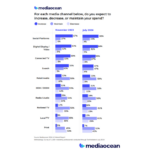Mobile devices continue to command the lion’s share of consumers’ digital time, with advertising dollars closely following suit. Yet, as the landscape of digital media evolves, connected TV (CTV) is emerging as a formidable contender, poised to capture a larger slice of the ad spend pie.
According to recent data, U.S. adults spend an average of 2 hours and 15 minutes daily with CTV—a notable 8.3% increase from the previous year. Despite this growth, CTV remains underrepresented in advertiser budgets. The primary reason is a limited supply of ad inventory coupled with high costs, explains Yoram Wurmser, an analyst at eMarketer. However, this dynamic is expected to shift as major streaming platforms like Netflix and Disney+ expand their ad offerings, and free ad-supported TV (FAST) services such as Tubi and Pluto TV continue to rise in popularity.
Currently, CTV accounts for only $0.13 of every hour U.S. adults spend with digital media per dollar spent on digital advertising, compared to mobile’s $0.51 per hour. This disparity underscores the potential for growth in CTV ad spend as more inventory becomes available and advertisers recognize the value in reaching audiences through this medium.
Wurmser advises advertisers to shift their focus from the device to the audience. “It’s crucial to follow your audience, understanding how they consume content,” he emphasizes. “While mobile and CTV devices dominate, it’s important to consider where your specific audience is most active, whether that’s on mobile, desktop, or another platform.”
Key Considerations for Advertisers:
- Digital Audio: With U.S. adults dedicating 1 hour and 24 minutes daily to digital audio, this channel presents a significant yet underutilized opportunity for advertisers. Despite its potential, digital audio currently has the lowest ad spend per user, at just $36.05 annually. This is starkly contrasted with digital video, which commands over $500 per user. “There’s a gap in spending here that advertisers could capitalize on, especially given the hours spent listening on phones and in cars,” Wurmser notes.
- In-App Advertising: Mobile devices dominate digital time, with over 90% of that time spent in apps. Consumers typically engage with around 20 apps regularly, making it critical for advertisers to identify where their target audience is most active. “Mobile attracts substantial attention and ad dollars for a reason,” says Wurmser. “Investing in the apps where your audience spends their time will yield the best return.”
- Tablets: While tablet use among U.S. adults peaked this year at 54 minutes per day, it’s expected to decline in 2025. Despite this, Wurmser advises advertisers not to overlook the device, noting that even a quarter of the time spent on mobile phones is still significant.
- Emerging Channels: For those looking to diversify, emerging channels like automotive consoles offer new opportunities. However, Wurmser cautions that these channels are still in the early stages of development. “There’s active work being done to make these channels more accessible for advertisers, but it’s still early days. It’s worth keeping an eye on these developments and starting to experiment with these platforms,” he suggests.
As advertisers navigate the evolving digital landscape, the key lies in understanding and adapting to where audiences spend their time, whether that’s on mobile devices, CTV, or emerging platforms.







Comments
Loading…